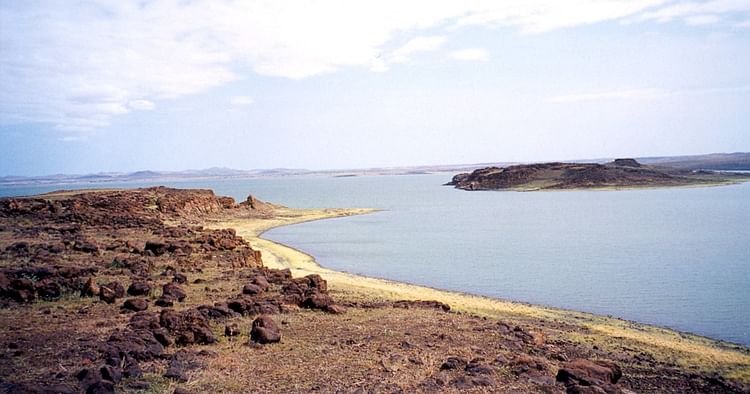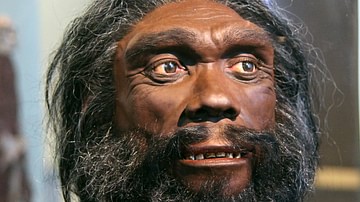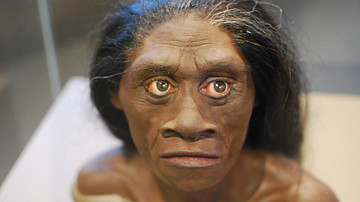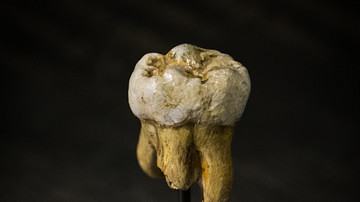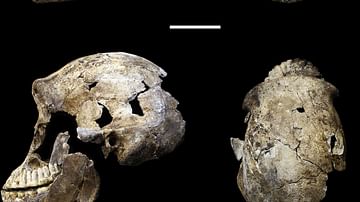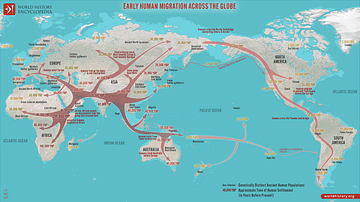Hunter-gatherer societies are – true to their astoundingly descriptive name – cultures in which human beings obtain their food by hunting, fishing, scavenging, and gathering wild plants and other edibles. Although there are still groups of hunter-gatherers in our modern world, we will here focus on the prehistoric societies that relied on the bounty of nature, before the transition to agriculture began around 12,000 years ago.
Prehistoric hunter-gatherers often lived in groups of a few dozens of people, consisting of several family units. They developed tools to help them survive and were dependent on the abundance of food in the area, which if an area was not plentiful enough required them to move to greener forests (pastures were not around yet). It is probable that generally, the men hunted while the women foraged.
Straight off the bat, it is important to realise that the variety between hunter-gatherer societies throughout time was so high that no single, all-compassing set of characteristics can be attributed to them. The earliest hunter-gatherers showed very different adaptations to their environment than groups at later points in time, closer to the transition to agriculture. The road towards increasing complexity – something we tend to consider to be the hallmark of 'modernity' - is a difficult yet interesting one to trace. Tools, for instance, became ever more developed and specialised, resulting in a large set of shapes that allowed hunter-gatherers to become better and better at exploiting their environment.
To say anything meaningful about prehistoric hunter-gatherers and their way of life, then, their developments and adaptations throughout time must be highlighted. This will allow us to catch glimpses of how different people may have interacted with their environments in different ways.
The Ice- & Stone Ages
First off, it will be useful to explain some terminology that is used to describe the time during which hunter-gatherers roamed the earth. Geologically, based on the repeating cycles of glaciation (or Ice Ages) during this time, the epoch spanning from roughly 2,6 million years ago to about 12,000 years ago is known as the Pleistocene. Archaeologically, based on stone tool cultures, the Palaeolithic Age falls within the same timeframe as the Pleistocene. The Palaeolithic is further subdivided into the Early- or Lower Palaeolithic (c. 2,6 million years ago - c. 250,000 years ago), which starts with the first recognisable stone tools found to this date; the Middle Palaeolithic (c. 250,000 years ago - c. 30,000 years ago); and the Late- or Upper Palaeolithic (c. 50,000/40,000 - c. 10,000 years ago), ending when the Ice Age ended and agriculture began taking over. The dates overlap here and there because some cultures persisted for longer in certain areas, while others had already developed to the point where they match the characteristics of the next age. It is interesting to stop and consider that although we may feel that our tech savvy, industrialised world has been around for a good while, the Palaeolithic actually makes up about 99% of human technological history.
The first hunter-gatherers
Our genus of Homo first developed within the massive space that is Africa, and it is there that hunter-gatherers first appeared. There are a few hotspots where the land clearly provided decently lush living opportunities and where the remains of often several different groups of humans living there at various times have been found. In southern Africa sites such as Swartkrans Cave and Sterkfontein show more than one occupation, although they are a lot younger than sites in eastern Africa, where in or near Ethiopia the earliest known stone tools made by humans – dated to c. 2,6 million years ago – have been found. One of the oldest sites is Lake Turkana in Kenya: it was already home to our presumed ancestors the Australopithecines, to which the famous Lucy belongs, and it continued to be a popular spot for a very long time indeed.
Dependency on the environment
From humans' early start in Africa to spilling out across Eurasia and later the rest of the world, all this exploration across vastly different terrains was done while living off the land by hunting and gathering what it had to offer. The amount of food, looking at both flora and fauna, directly impacted the amount of people an environment could feasibly support. If food was abundant, resident groups of hunter-gatherers were more likely to stay in the same place, find ways to effectively store their food, and protect their territory against competing groups. Alternatively, if there was not enough food in a group's direct vicinity, it meant they had to move around and lead more nomadic lifestyles in order to sustain themselves. If this sounds like too much of a piece of cake, imagine that the environment with both its terrain and its weather (think of droughts or huge storms) regularly tried to kill these early humans, with the assistance of animals that had bigger teeth and claws than they did. Luckily, prehistoric societies were made up of groups or bands of a few dozens of people, usually representing several families, that helped each other survive mother nature.
The geographical spread of early man was so vast it is useful to elaborate on this a little. A huge continent such as Africa in itself already hosts all sorts of different landscapes, although in general, some degree of sun and heat would have been part of the deal, but once man spread beyond its borders, a whole new kind of adaptability would have been necessary. Early bands of Homo erectus were likely among the first to venture out into new worlds, nearly 2 million years ago, spreading out all the way to Eurasia, China, and Indonesia by c. 1,7 - c. 1,6 million years ago, although a few older finds - tools made by unknown species - spanning between roughly 2,6-2 million years from those regions are also known. These help illustrate how complex the history of early human migration must have been. Europe was most likely not explored until much later; although the Mediterranean shows some tentative human activity before 1 million years ago, the major mountain ranges were not braved by daring travellers (usually thought to have been Homo heidelbergensis) until around 700,000 years ago. Once they had crossed, they flourished. Neanderthals later evolved from this population and themselves ended up expanding beyond their initial European homes into both the Near East and parts of Central Asia, up to the Altai region in Siberia where the remains of a sister-species of theirs, the Denisovans, were also found. By the end of the Middle Palaeolithic, almost the entirety of the Old World had been reached by some group of humans. Insular Asia, Australia and the New World would also all be conquered by humans by the end of the Pleistocene. With our planet covered, there was no environment to which we did not eventually learn to adapt.
Genetic studies are doing their best to come closer to a coherent picture of just how quiet or busy the world must have generally been during the Pleistocene. None has emerged just yet, but a non-genetic estimate of around 500,000 individuals is in agreement with a lot of the recent genetic results. In general, areas would not have been very densely populated. One might wonder what prehistoric man or woman would have to say about our present-day self-proclaimed modernity, which has spawned many massively polluted cities.
Shelters
Mostly, these prehistoric hunter-gatherers would have used natural shelters as living space; overhanging cliffs would have provided a place to nestle into to escape the wind and rain, and caves were highly popular as comfortable living spaces could be created within, mostly near the entrance to stay in range of the daylight. However, open sites, more exposed to the elements, have also been found.
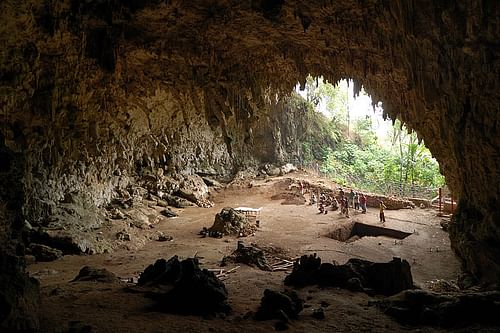
In the Upper Palaeolithic, humans became ever more inventive and organised, as manmade structures were now created to a much higher degree than before. They offered an alternative to the still very popular cave life, but caves, of course, were not available everywhere, and they were so popular among cave bears and cave lions that it gave them their names. Thus, some societies built huts or tents with wooden supports, or even with mammoth bones forming the structure, which were also illuminated by the light of hearths and had clear architectural features that organised the spaces into designated areas. Materials and tools were moreover much more commonly transported over long distances than they were in the Middle Palaeolithic. However, it is in the persistently useful caves that one of the greatest developments of the Upper Palaeolithic is visible: brilliant cave paintings, such as those at Chauvet Cave or the famous Lascaux Cave, both in present-day France, provide some stunning examples of hunter-gatherer art. Often connected with symbolic thought, it is this that greatly sets these later hunter-gatherers apart and forms part of why they are generally considered to be full-fledged modern humans.
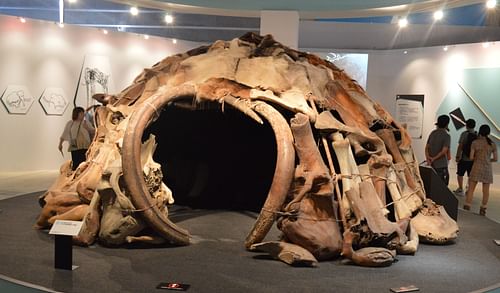
Food
The exact types of food hunter-gatherers consumed obviously varied depending on the landscape and its resident flora and fauna. Whereas some might specialise in hunting the impressive prehistoric megafauna such as the megaloceros or giant elk, woolly mammoths and woolly rhinoceros, others might focus on trapping small game or on fishing. Although their name implies an active stance, hunter-gatherers most likely scavenged to some degree too.
The earliest humans in Africa were still quite far removed from woolly mammoth-hunting, however, and not just because the time and geographical location do not quite match. They had no sophisticated hunting tools or strategies capable of bringing down quite such enormous prey as of yet, but they did eat meat. After these people had obtained their food, however, they still had to process it. For this, either powerful teeth – for grinding down tough plants with strong molars or biting into non-butchered flesh - or tools that did that for them were needed. Early humans, in general, went down the path towards smaller teeth. Already in species such as Homo rudolfensis the molars were not as large as their ancestors', and later species such as Homo habilis and Erectus continued this trend. Teeth size declined, while at the same time brain size grew. They made up for their smaller teeth by developing a stone tool culture, which allowed them to more efficiently exploit their environment than ever before. As such, these humans became more omnivorous - and thus, more versatile and adaptable - by adding more meat to their previously pretty green diet.
Because plant remains do not stand the test of time as well as butchered animal bones do, it is generally hard to determine exactly what our ancestors' veggie habits were like. However, a recent 2016 study gives us a rare glimpse into the plant diet of the people living at Gesher Benot Ya'aqov, Israel, some 780,000 years ago. A stunning 55 kinds of food plants were found there that include seeds, fruits, nuts, vegetables, and roots or tubers. The diversity shows these people had a good knowledge of which edible things could be found in their environment, and in which season, and reflects a varied plant diet. Besides the greens, the diet of this particular hunter-gatherer society also included both meat and fish. Moreover, fire was visibly used in food processing by this group, while cooking and the habitual use of fire seem not to have been widespread until around 500,000 - 400,000 years ago (see below). Whether this site just housed a group of prodigies or whether more general conclusions can be drawn from this is hard to say – it must at the very least be viewed in its geographical and chronological framework.
A bit further along the timescale, Middle Palaeolithic sites show more evidence of local traditions and variation being present. As humans were now well-established both inside and outside of Africa, and had spanned out far north as well as east, population density increased, and that had an effect on the available food. Under the yoke of increased competition, hunters came up with new tactics and began picking targets across a wider range than before. When they were available, however, the prized large- or medium-sized deer, horses, and bovids like bison and gazelle presented too good of an opportunity to pass up. These were definitely the top picks on the hunter-gatherer menu.

'The bigger the animal, the better' is a philosophy that definitely holds up when one is concerned with feeding a whole band of hungry humans leading active lives. For living that dream, the time to be alive was the Late Pleistocene (c. 120,000 - 10,000 years ago), specifically in the main part of Eurasia and stretching all the way into eastern Siberia. There, humans would have found an astonishingly high concentration of megafauna such as mammoths, woolly rhinoceros, Lena horse, and bison, in what has been called the 'Mammoth complex'. Neanderthals, for instance, surely took advantage of this: they are known to have eaten a fair amount of mammoth and rhino meat, besides other meat from mammals such as bison, wild cattle, reindeer, deer, ibex and wild boar. Otherwise, various legumes and grasses, fruits, seeds and nuts generally made up a substantial part of their diet, like it must have done for most hunter-gatherer societies throughout time. The idea that they were mostly meat-eaters (apart from their early beginnings) has long since been overthrown. Recently, an interesting window into the past opened up at a site called Shubayqa 1 in northeastern Jordan. Archaeologists that were excavating a hearth lined with stones found fragments of an ancient unleavened type of bread there, made by a human culture living at the site around 14,400 years ago - a staggering 4000 years before agriculture cropped up in this region.
Tools
First of all, it must be explained that the categories we have come up with to classify ancient tools are only broad, rough indicators encompassing certain sets of characteristics that we ourselves have gathered together. Tools had to be functional in their direct environment and were made with products coming from that environment, rather than adhering to some sort of 'unspoken' trend that telepathically entered the minds of all early human toolmakers.
The tools used by hunter-gatherers to make their lifestyle possible had their humble beginnings, so far traced back to around 2,6 million years ago, in the Oldowan technology (lasting until c. one million years ago). Simple stone cores were used as choppers, hammerstones, and retouched flake scrapers, in order to both cut the meat off of animals and get to the nutritious marrow inside, or process plants and seeds. This technology was brought out of Africa towards Asia by early waves of Homo erectus that went adventuring.
In Africa, in the meantime, what we call the Acheulean (c. 1,7 million years ago to c. 250,000 years ago) had begun to evolve, which came to Eurasia a bit later on. It saw the development of tools into large bifaces like hand axes, picks and cleavers, enabling Homo erectus, and later on Homo heidelbergensis, to literally get a better grip on the processing of their kills. Although wood of such age generally does not survive, a site in Northern Europe suggests that wooden tools may well have been a part of the daily life of early hunter-gatherers too, presumably stretching all the way into the Middle Palaeolithic.
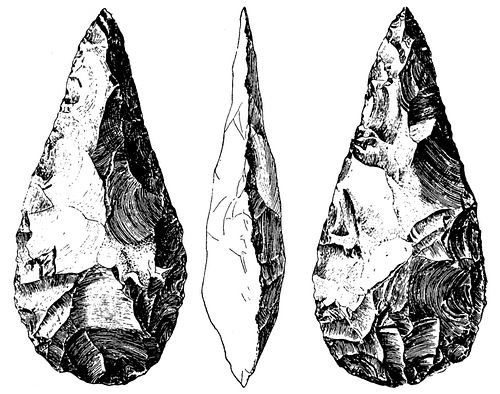
Tool use was by now decently established, and the following Middle Palaeolithic saw a fine-tuning; retouched flake tools, such as scrapers, points, and backed knives were made by early precursors to Homo sapiens, Neanderthals, and the earliest anatomically modern humans. A huge proliferation then occurred in the Late Palaeolithic, where blade tools were created alongside bone, antler and ivory artefacts, and even such technological feats as spear throwers and bows and arrows began to appear. All in all, around the world, as time went on more and more variability appeared in the stone industries we are uncovering, which not only suggests increasing innovation over time, but also the presence of stronger regional (material) cultures.

Fire as a catalyst
Besides the development of tools, another huge change that had an incredible effect on our species is the harnessing of fire. In short, the use of fire meant our ancestors could huddle around it for protection (wild animals in general are not very keen on fire) and warmth, and it allowed them to cook their food - which has an amazing array of benefits. Fire thus plays a central role in human survival and in catalysing the processes of becoming 'human' as we define it.
The earliest evidence we have found so far for the use of hominin fire dates back to over a million years ago. Around Lake Turkana fire is indicated from around 1,8 million years ago onwards; sites show reddened patches and, for instance, stones altered by heat, but the early African sites show no certain signs of hearths. Indeed, throughout this early stage traces of fire remain very rare on African open sites. Here, fire use may have been more connected to taking advantage of natural fires, such as forest fires or the after-effects of a particularly violent lightning strike, rather than actively creating and maintaining it personally.
It is hard to accurately trace the way in which the use of fire gradually developed throughout time, after its first beginnings. However, by at least 400,000 years ago it is clear that the human bands roving around and setting themselves up in caves not just in Africa, but also the Middle East and Europe, knew and used fire; clear evidence of hearths has been found in Acheulean levels. These people were clearly skilled at maintaining and using fire. Over the next 100,000 years, the habitual and very deliberate use of fire becomes very apparent, like for instance in the Middle East and even at open sites in southern France. It thus became a central part of the hunter-gatherer lifestyle.
Fire had important benefits. Apart from protection and warmth, which would have helped even the earliest, basic fire users to survive, a major advantage that came when the deliberate use of fire began to become more widespread is the ability to cook. Until around 500,000 years ago, cooking seems to have been a rare sight within hunter-gatherers societies. What happened when humans did convert to sizzling their bison steaks and the likes is as follows. Firstly, cooking softens the food, making it easier to chew and digest, which meant people could develop smaller teeth and less long digestive systems, and spend less of their time digesting their food. The traditional hunter-gatherer diet is moreover so hard to ingest and digest in its raw form that cooking, in addition to the calorific benefits, really represented a big change. It also left these early humans' brains free to grow to a larger size than previously possible; large brains are more complex but also more expensive and require high-quality foods. Of course, having larger and more complex brains meant that humans could come up with better ways to maintain and use fire, develop better hunting strategies, and so forth. Thus, the cycle continued.
Fire in general also had an impact on the social side of these hunter-gatherer groups. Fire, with the light it provided, enabled hunter-gatherers to stay active even after sundown, extending their days and leaving more time for social bonding, which is very important especially in larger groups. Modern humans are awake for nearly twice as long as many of their primate cousins.
The social side
This prehistoric lifestyle, with groups sharing and organising a living space, and working towards keeping everyone alive, clearly had some sort of social side to it. Research suggests that a kind of social network structure could well have appeared quite early on in human history, with connections stretching not just to family members but also to non-kin, and that this social aspect may have helped spark (increasingly intensive) cooperation. The hunters at Schöningen, for instance, that are discussed above and belong to a group of Homo heidelbergensis, or at comparable sites such as Boxgrove and Arago, were seemingly so successful they may have been able to get their hands on large amounts of meat. If this was indeed the case, they may have shared or exchanged food with other groups in their neighbourhood, maybe even at established meeting places.

The sheer amount of different Homo species that passes the revue in the space above should already be an indicator of just how diverse hunter-gatherers were: each species had different strengths and weaknesses, and differently structured societies, although with time almost all of these humans walked the road that eventually led to agriculture. The exceptions? Some hunter-gatherer societies persist to this day.


